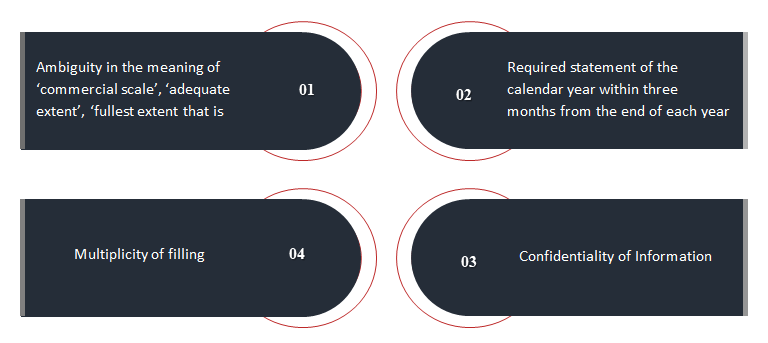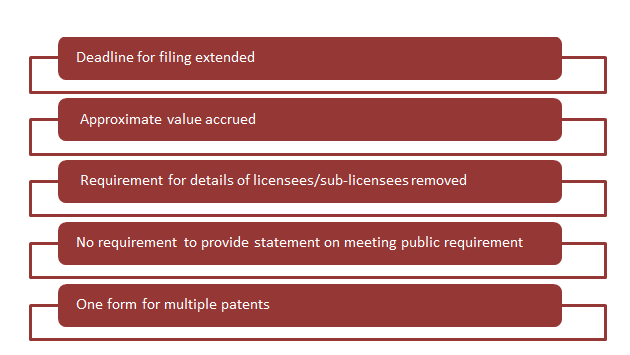Amendments to Form 27 (Indian Patent Act) – Evaluating the Commercial Applicability of a Patent
Patents are granted not only to offer protection, but also to ensure that they are worked commercially to the fullest extent possible. A patent without any real-life application does not contribute to solve any pressing problem in the society. Hence, the clause of ‘working of patent’ commands extra attention from the patent legislators and examiners. In India, Form 27 of “The Patent Act, 1970 (39 of 1970) & the Patents Rules, 2003”, requires a statement from the patentee/licensee regarding the working of the invention on a commercial scale in India.
The following article discusses the importance of Form 27, its development and amendment to the original clause of working of patent (Patent Act 1970), the need for amendment, comparison between the new and old formats, and the efficacy of the recent amendment. But first, let us understand the background of Patent Law and Form 27 in India.
Table of Contents
History of Indian Patent Act, 1970 and Form 27
In India, it is compulsory under the (Indian) Patents Act, 1970 for every patentee/licensee to furnish a statement as to the extent of commercial working of a granted patent in the Indian territory. The working idea is embodied in Form 27 of the “2003 Patent Rules.” Non-adherence with the requirement of filing the working statement within the timelines may invite a penalty of imprisonment upto six months, a fine, or both, as provided under section 122(1) (b) of the Patents Act. Accordingly, the relevant information needed from the patentee/licensee under Form 27 has been listed below:
- If the invention has been applied on a commercial scale.
- The reasons behind not applying the invention and the steps taken to apply it.
- If the invention has been applied, the quantum and value in INR of the patented product: (a) when manufactured in India; (b) when imported from other countries, providing the details of the countries concerned.
- Licenses and sub-licenses granted during the year.
- Whether the public requirement has been fulfilled, at a reasonable price either partly, adequately or to the full extent.
Prior to the amendment, the law also required that the patentee/licensee file the above information every calendar year within three months of the year-end. Therefore, the latest date a patentee or licensee could file such information for a given calendar year was March 31st.
While the act was meant to increase compliance and increase the working of patents, the result was not achieved, as revealed by public interest litigation (PIL) filed before the Delhi High Court in 2015. Form 27, while speaking of public requirement, did not clarify numerous points, including what was meant by ‘adequate extent,’ ‘fullest extent that is reasonably practicable,’ ‘commercial scale,’ and so on.
The ambiguity in the old Form 27 triggered the need for an amendment that could increase compliance, streamline the process of patent drafting and examination, and address the critical concerns of the stakeholders, such as patentee, licensee, examiners, etc.
Reasons behind Amendments in Form 27
Figure 1 below lists the prime reasons for the amendment in Form 27.

1. The meaning of ‘commercial scale,’ ‘adequate extent,’ ‘fullest extent’ that is reasonably practicable, etc.
The PIL filed before the Delhi High Court in 2015 stressed on the expression and requirements of Form 27 mentioned in the 2003 Rules. One example of such a condition was to state whether the patentee had fulfilled the public requirement related to the patented invention “partly/adequately/to the fullest extent” without any guidance on how to determine the same. In the absence of any set standard, the patentee interpreted the requirement as per their subjective understanding.
2. Required statement of the calendar year within three months from the end of each year
Form 27, present in the 2003 Rules, required the patentee to furnish a statement of the calendar year within three months from the end of each year. It made gathering and organizing the information challenging as most organizations are used to the financial year cycle. In addition, the deadline for filing was also limited, i.e., three months from the end of each calendar year, which collides with the end of the financial year, increasing the probability of missing the deadline.
3. Confidentiality of Information
Form 27 of the 2003 Rules required the patentee to furnish details regarding the quantum and value of the manufactured product. The requirement raised the concern if such sensitive information could remain confidential. To the disappointment of many patentees, neither the Patent Act, 1970, nor the Patents Rules, 2003, elaborates on how such sensitive information is made available to the public.
The act only says, “the Controller may publish the information as prescribed under the relevant section, i.e., (S. 146(3) read with r. 131(3).” Besides, section 145 states that the patent controller shall periodically publish an official journal covering information that may be required to be published under the act. With this context, it can be presumed that information submitted under Form 27 could be published at the controller’s discretion.
4. Multiplicity of filing
The old Form 27 of the 2003 Rules required patentees to file a separate form for each patent even if they were related and approximate revenue/value accrued from a particular patented invention could not be obtained separately from the approximate revenue/value accrued from related patents. The assortment of filing posed a hurdle for patent owners looking for seamless and timely compliance.
Now that we have looked into the problems that made the amendment necessary, let us look at how Patent (Amendment) Rules 2020 (“Amended Rules”) addressed them.
Amendments to form 27 carried out through the amended rules
The significant amendments made by way of the amended rules are shown in Figure 2 below:

1. Deadline for Filing Extended: After the new amendment, Form 27 has to be furnished for every financial year instead of the calendar year in the old rules. The deadline for filing is six months from the expiry of every financial year, which is by September of the year after the relevant financial year. The switch from calendar year to financial year has been appreciated by patentees and licensees as the collation of information for a financial year will be much easier. In addition, the new rules also allow extra three months for filing Form 27, allowing the desired cushion in the case of an emergency.
2. Approximate Value Accrued: As per the New Form 27, the patentee/licensee is required to submit only the approximate revenue/value accrued in India through manufacturing in India or import into India of the patented invention. The 2003 rules required the patentee to list out the “quantum and value (in rupees) of the patented product manufactured or imported in India.”
The change has been hailed as a great move as patentees routinely faced obstacles in finding out the exact quantum and value of the patented product manufactured/imported in India. For some inventions, the exact figures are not easily discernible, and there are genuine apprehensions over confidentiality. As per the amended rules, patentees/licensees need only provide approximate values making compliance more straightforward and less cumbersome.
3. Requirement for Details of Licensees/sub-licensees Removed: In the old Form 27, the requirement to provide details of licensees and sub-licensees was another cause of concern from the confidentiality perspective. The new Form 27 has done away with this requirement, bringing relief for the patent portfolio owners and managers. When publicly available, details of licensees and sub-licensees can reveal a lot about a company’s patent licensing strategies, resulting in competitive disadvantages.
4. No Requirement to Provide Statement on Meeting Public Requirement:As per Form 27 of the 2003 Rules, a patentee was asked to state if the public requirement for the patented invention was met partly/adequately/to the fullest extent at a reasonable price. The underlying problem in the condition was that there was no clear definition or guidance on how to conclude if a patentee had met the public requirement “partly/adequately/to the fullest extent.” Much to the solace of patentees, the controversial statement has been removed by way of the Amended Rules.
5. One Form for Multiple Patents: With the introduction of new amended rules, a patentee can now file one form for multiple patents if all such patents are related patents and approximate revenue/value obtained from a particular patented invention cannot be obtained separately from the approximate revenue/value accrued from the related patents. The change has resolved the issue of multiplicity of filings for a set of related patents.
Apart from these significant changes, the amendment also made other changes. Table 1 shows the salient differences between old Form 27, proposed Form 27, and new/amended Form 27.
| S. No. | PREVIOUS FORM 27 | PROPOSED FORM 27 | NEW/AMENDED FORM 27 |
| 1 | Required a separate form to be filed for each patent | Required a separate form to be filed for each patent. However, it needed details of all related patents to be provided, where the value accrued from a particular patented invention could not be obtained separately from the value accrued from related patents, and all such patents are granted to the same patentee | Gives an option to file one form in respect to multiple patents, provided all of them are related patents, wherein the approximate revenue or value accrued from a particular patent cannot be obtained separately from the approximate revenue or value accrued from related patents, and all such patents are granted to the same patentee |
| 2 | Needed statement of the calendar year related to working of patents. Previously, Patent Rules, 2003 required Form 27 to be filed for every calendar year within three months from the end of each year | Needed statement of the calendar year related to working of patent. Previously, Patent Rules, 2003 required Form 27 to be filed for every calendar year within three months from the end of each year | Needsstatement of the financial year related to working of the patents. Amended Rule requires Form 27 to be filed in respect of every financial year within six months from the end of each financial year |
| 3 | Patentees/licensees were only required to share whatever details were available | Patentees/licensees were required to share all the sought-out details in the form | Patentees/licensees have to disclose all the sought-out details in the form |
| 4 | There was no word limit for mentioning why the patented inventions had not been worked and what were the steps planned and taken to work on patent inventions if it has not been worked | A word limit of 500 words was proposed for mentioning the details with suitable justification for not working the patented inventions | Prescribes a word limit of 500 words for detailing reasons of not working the patented inventions and steps taken for working the invention |
| 5 | It required the statement about quantum and value of the patented product that had been manufactured or imported, provided the invention had been worked | It required approximate value accrued by patentee/licensee from patented inventions in India by manufacturing/importing. The form did not ask for quantum of the patented invention manufactured/imported to be stated | It requires approximate value accrued by patentee/licensee from patented inventions in India by manufacturing/importing, if the inventions have been worked. The form also requires a brief of five hundred words with respect to the above point. Much to the relief of patentee/licensee, the practice of stating quantum of the patented invention manufactured/imported has been done away |
| 6 | In case the patented product has been imported from other countries, it needed country wise details | There was no requirement to provide country specific details if the patented products had been imported from foreign countries | It does not ask for country specific details to be shared if the product is imported from other countries |
| 7 | The disclosure about licenses and sub-licenses granted with respect to the patented product during the year was mandatory | The disclosure about licenses and sub-licenses granted with respect to the patented product during the year was not mandatory | Does not need disclosure of licenses and sub-licenses granted during the year in respect of the patented product |
| 8 | The statement about whether public requirement of the patented product has been met partly/adequately/to the fullest extent at reasonable price was compulsory | Did not need statement about whether public requirement of the patented product has met partly/adequately/to the fullest extent at reasonable price | It does require statement of whether public requirement of the patented product has met partly/adequately/to the fullest extent at a reasonable price |
| 9 | The signature by the person furnishing the statement was mandatory | It needed signature by patentee/licensee furnishing the statement | It requires signature by patentee/licensee or authorized agents providing the statement |
| 10 | There was no note emphasizing that every patentee/licensee is required to file the form as made mandatory by section 146 of the Patents Act, 1970 and Rule 131(1) of Patent Rules, 2003 | Added a note emphasizing the point that every patentee/licensee is required to file the form as made mandatory by section 146 of the Patents Act, 1970 and Rule 131(1) of Patent Rules, 2003 | Adds a note highlighting that every patentee/licensee is required to file the form as made mandatory by section 146 of the Patents Act, 1970 and Rule 131(1) of Patent Rules, 2003 |
| 11 | Lack of clarity on filing – whether multiple owners of a patent could together file the form or the form had to be filed separately | It allowed multiple owners of a patent the option to file the form jointly but also clarified that every licensee must also file the form individually | It provides multiple owners of a patent the option to file the form jointly but also clarifies that every licensee must also file the form individually |
After discussing the changes between the old Form 27 and the new one, let us move our discussion towards the possible loopholes in the new form.
Will the New Amendment Strengthen or Weaken the Purpose of Furnishing Working of Patent Information?
The new Form 27 is undoubtedly an improvement over the old and proposed ones. It has brought in the requirement for stating the reasons if the invention has not been worked out. There is also the requirement to furnish the steps being taken towards working the invention (with an arbitrary word limit of 500 words), whereas the proposed form only required justification for not working the patent inventions.
However, besides the advantage stated above, the new form has a few hiccups that need to be dealt with:
- Quantum of the Invention: The new Form 27 does not demand exact information on the quantum of the invention. There seems to be no justified explanation to eliminate the information on total units of patented invention imported and manufactured in India. The data is significant in determining the extent of the working of patent and plays a crucial role in facilitating the compulsory license regime. For instance, NATCO Pharma successfully convinced the authorities to grant a compulsory license due to Bayer’s disclosure through the old form 27. Without the exact quantum manufactured and imported information, it would have been impossible to determine if the patent had been worked in India.
- Extent of Meeting the Public Requirement at a Reasonable Price: The new Form 27 has done away with the need to provide detailed information about the extent to which the working of patent has met the public requirement at a reasonable price. The relaxation on furnishing critical information, such as estimated demand of the patented invention or product, the level to which the demand has been met, and the details of any particular schemes or steps undertaken by the patentee to satisfy the demand, eliminates the possibility of assessing the working of patent. Without such information, it would be a challenging task to conclude whether the invention has been made available and is affordable to the public.
- The Number of Licensees and Sub-licensees Granted: Similar to relaxations on other points, the new Form 27 does not require patentees/licensees even to furnish details about the existence of licenses/sub-licenses. The step to do away with disclosing details means patentees and licensees will only be self-certifying that they have worked the patent without any substantial claim backed up by data on licensing and sub-licensing.
- Word Limits Offer an Additional Escape Route: Besides reducing the volume of information required to increase compliance, the new form has prescribed an arbitrary word limit of up to 500 words to justify not working of a patent. The reduced word limit will prevent the patentee/licensee from submitting the necessary information on why the patented invention has not been worked. Moreover, it may also encourage crafty patentees to reveal minimum obscure information and then avoid accountability by citing word limit as an excuse.
Conclusion
We can say that the new Form 27 has its flaws as well as its advantages. The new form is a change long sought by patentees and licensees as it eliminates ambiguity and requires less information. However, from the regulators’ perspective, the need to provide approximate details of information in limited words poses a significant challenge in determining the working of a patent.
Many patentees and licensees file Form 27 on their own. However, the task becomes mind-boggling when there are multiple unrelated patents, each with its requirements. In such instances, it is better to avail of the services offered by a reliable third party.
Sagacious IP offers a range of intellectual property solutions for inventors, businesses, law firms and more. Its India Patent Filing and Prosecution services enable you to secure your invention by leveraging a solid patent draft prepared by a skilled patent attorney that ensures your invention is protected in the most cost-effective and swift manner. Get in touch now to know more about this and various other services offered by Sagacious IP.
– Shweta Sharma (IP Filing & Prosecution) and the Editorial Team
Having Queries? Contact Us Now!
"*" indicates required fields




